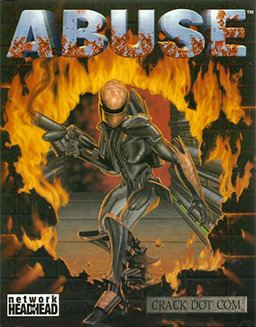Composer(s) Robert Prince Initial release date 1995 | Genre(s) Run and gun | |
 | ||
Release date(s) DOSNA: February 29, 1996EU: 1996Mac OSNA: March 5, 1997AmigaEU: 1998iOSAugust 13, 2009LinuxOctober 11, 2011 Platforms Linux, Macintosh operating systems, iOS, DOS, MS-DOS, Android, AmigaOS, BeOS, Acorn Archimedes, GP2X, GP2X Wiz Modes Single-player video game, Multiplayer video game Similar Bungie games, Shooter games | ||
Abuse is a run and gun video game developed by Crack dot Com and published by Electronic Arts in North America and Origin Systems in Europe. It was released on February 29, 1996 for MS-DOS. A Mac OS port of the game was published by Bungie and released on March 5, 1997. The game's source code, along with some of the Shareware content, has been in the public domain since the late 1990s and has been ported to Linux and other platforms.
Contents
Plot
The protagonist of the game, Nick Vrenna, has been unjustly incarcerated in a prison where the staff are performing unethical medical experiments upon the inmates. A prison riot occurs and an experiment goes horribly wrong. The people inside the prison - except for Nick, who seems to be immune - get infected with a substance called Abuse that transforms them into monsters. With the water supply in danger of being infected, Nick arms himself and fights through the horde to prevent this, and then escapes from the prison complex.
Gameplay
Abuse resembles a side-scrolling platform game. The game is notable for its (at the time) unusual control scheme: The keyboard is used to move Nick, while the mouse is used for aiming the weapons. The basic gameplay consists of fighting various enemies (mostly the various forms of mutants, who prefer to attack in huge swarms) and solving some simple puzzles, usually involving switches.
Networked play, through IPX/SPX, is also supported. The game originally had support for TCP/IP play, but this was not present in the retail version.
Active zone
To improve the performance of Abuse's graphics engine, the code only allows objects within a certain radius of the visible game window to be active during play. This means that free-roaming enemies and always-on mechanical devices outside the radius cannot attack the player, nor will projectiles fired from weapons that ostensibly have an "infinite range" continue their journey much beyond the edge of the screen.
Development
Abuse had a very different storyline coming out of production. The update for it replaced the original introduction with the current storyline. The original involved an invasion by an alien species called "ants". The player was a special ops agent, sent into their 'hive' to covertly destroy the aliens by shutting down the cooling system. This story was alluded to in a hidden section towards the end of level 14, where a large area, full of maroon tiles, can be found.
Release
On February 29, 1996 Abuse was originally released for DOS and Linux as an incomplete shareware version by Electronic Arts in North America and Origin Systems in Europe. The game was ported to Mac OS by Oliver Yu of Crack dot Com and published by Bungie Studios on March 5, 1997. The port was largely reworked for Mac, with the graphics partially redone to work better in the 640x480 resolution.
Source code release
Approximately two years after the release of the game, Crack dot Com decided to release the game's source code, as well as the shareware release game data (excluding the sound effects), into the public domain.
Based on this source release there has been initially mostly maintenance work, e.g. making the game work over TCP/IP. With the adoption of SDL multimedia library for Abuse in 2001 porting to other platforms became feasible. The SDL port allowed up-to-date builds with more than 256 colors, for instance Microsoft Windows, Linux/X11 and also the Mac version has been updated to run on OS X.
Community development
Based on the SDL version, ports were created for various system over the years. For instance, the game is available for BeOS and Nintendo Wii via Wii homebrew. In 2009 Abuse was ported to AmigaOS 4. The game has also been ported to the iPhone/iPod Touch under the name Abuse Classic. Until 2011 the game was maintained by Sam Hocevar on his webpage. The game was ported to SDL2 in 2014 and transferred to a GitHub repository.
In 2016, on the 20th birthday of the game, a community developer released a "20th anniversary source port" on base of the previous works which enabled custom resolutions, OpenGL rendering, Xbox 360 controller support and fixed the music.
Reception
Reviewing the DOS original, a Next Generation critic said the game "has everything it needs to be a great arcade classic - intuitive play control, a variety of weapons, creatures, devices, and traps ... scores of secrets to be ferreted out." He also praised the inclusion of an accessible level editor, and said the game's strongest point is the depth of its challenging puzzles, though he criticized the lack of story. He scored the game 4 out of 5 stars.
